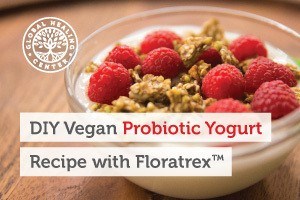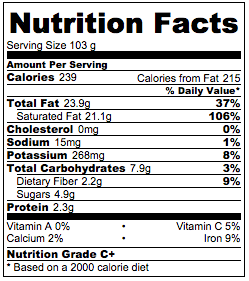
Probiotics are one of the best ways to maintain gut health, but if you’re dairy-free, you might have a little trouble finding a store-bought probiotic yogurt that meets your needs. When you do manage to find them, vegan yogurts found in the grocery store tend to be rather more expensive than the dairy-based ones. So what do you do? You buy some full-fat coconut milk and you make it yourself!
This vegan probiotic yogurt recipe is extremely easy—all you need is a little bit of time and just four ingredients. Making your own yogurt is a great way to avoid all the unhealthy additives found in store-bought yogurts, like artificial and refined sugars. Over-processed and bleached refined sugar is linked to several diet-related health problems like heart disease, [1] type 2 diabetes, [2] Alzheimer’s disease, [3][4] and many others. Artificial sugars, like sucralose and aspartame, are linked to weight gain, obesity, and a craving for progressively sweeter foods. [5]
Why You Should Eat Yogurt
The health benefits of eating yogurt are real (and delicious). Yogurt contains probiotics, which are live, cultured bacteria that are good for your gut. These beneficial bacteria are cited with providing many health-supporting benefits for those with concerns such as:
- Inflammatory bowel diseases
- Allergies and eczema
- Oral health problems
- Digestive upset (diarrhea) from infections or antibiotic use [6]
In order to be formally considered yogurt, the probiotic mix you add to your yogurt’s base must contain both Lactobacillus bulgaricus and Streptococcus thermophilus. [7] Probiotics work by competing with pathogenic (disease-causing) microorganisms for space and resources in your intestines. Probiotics antagonize unhealthy microbes and regulate your immune system’s response to them. [8]Floratrex™, the probiotic in this recipe, features L. bulgaricus, S. thermophilus, and 21 more beneficial health-promoting strains for a healthy, happy microbiome.
Vegan Probiotic Yogurt with Floratex Prep Time
- Culture time: 12-24 hours
- Refrigerate for 6 hours minimum
- Total time: 18-30 hours

Supplies for Vegan Probiotic Yogurt with Floratex
- Glass bowl
- Food-safe thermometer
- 2 large canning jars
Ingredients for Vegan Probiotic Yogurt with Floratex
- 2 cans of organic full fat coconut milk
- 1 tbsp. organic maple syrup
- 1 tsp. of Floratex (empty about 5 capsules into a small bowl)
- 2 tsp. of organic agar flakes or tapioca starch, keep the preparation instructions within reach
Vegan Probiotic Yogurt with Floratex Directions
- Combine coconut milk and maple syrup in a saucepan and whisk together for about 10 seconds. Set the burner to medium heat.
- Once the coconut milk mixture starts to boil, immediately remove from heat.
- Pour saucepan contents into a clean glass bowl. Complete steps 4, 5, and 6 while the milk cools.
- Monitor the temperature of the coconut milk with a food-safe thermometer until it reaches 115° F.
- While the coconut milk is cooling, prepare the thickener (tapioca or agar) in another bowl using the appropriate method. (Unfortunately, preparation directions for agar and tapioca differ based on brand. Check the packaging for specific instructions.)
- Once the thickener has completely dissolved, stir it into the bowl of coconut milk.
- Carefully sterilize your jars, rings, and lids in a pot of boiling water. Boil for 15 minutes. Remove from heat and pull jars out with tongs. Be careful not to burn yourself on the hot water.
- Once the coconut milk cools to 115°F, stir in the contents of 5 Floratrex capsules. Do not mix in the actual capsules—open and shake out contents before adding Floratrex to the bowl. Stir until well combined.
- Pour the yogurt into a sterilized glass jar and screw the lid on tightly.
- Wrap jars in a towel to insulate them.
- Place jars into an unheated oven with the light on, or in your yogurt maker. Alternatively, use a heating pad on a low, or use hot water bottles to keep your yogurt at 105°-115° F while they culture for the next 12-24 hours. The longer your yogurt cultures, the tangier (more like Greek yogurt) it will become.
- Once you’re done culturing your yogurt, place it in the fridge for at least 6 hours to suspend the fermentation process. As the yogurt cools, it will thicken.
- Once cooled, you’re free to eat your homemade vegan yogurt! Add it to recipes for a creamier consistency or mix in some fruit and nuts for a cool, tart breakfast.
References
- “Added Sugars Add to Your Risk of Dying from Heart Disease.” 16 Sept. 2016. Web. 10 Oct. 2016.
- Bunim, Juliana. Quantity of Sugar in Food Supply Linked to Diabetes Rates. UC San Francisco, 27 Feb. 2013. Web. 10 Oct. 2016.
- Purdy, Michael C. “Scientists find new link between diabetes and Alzheimer’s | the source | Washington university in st. Louis.” Medicine & Health. The Source, 4 May 2015. Web. 10 Oct. 2016.
- Moreira, Paula I. “High-sugar diets, type 2 diabetes and Alzheimer’s disease: Current Opinion in Clinical Nutrition & Metabolic Care.” (2013): n.pag. Web. 10 Oct. 2016.
- Strawbridge, Holly. “Artificial sweeteners: Sugar-free, but at what cost? – Harvard health Blog.” Diet and Weight Loss. Harvard Health Blog, 16 July 2012. Web. 10 Oct. 2016.
- Supplements, Encyclopedia of Dietary. Probiotics: In Depth. NCCIH, 4 May 2016. Web. 10 Oct. 2016.
- “CFR – Code of Federal Regulations Title 21.” Jan. 2016. Web. 10 Oct. 2016.
- VP, Singh, et al. “Role of probiotics in health and disease: a review.” JPMA. The Journal of the Pakistan Medical Association 63.2 (2013): 253–257. Web. 10 Oct. 2016.
The post DIY Vegan Probiotic Yogurt Recipe with Floratrex™ appeared first on Dr. Group's Natural Health & Organic Living Blog.
source http://www.globalhealingcenter.com/natural-health/diy-vegan-probiotic-yogurt-with-floratrex/
No comments:
Post a Comment